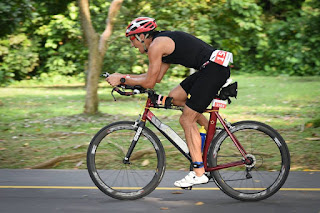In the last few years, I
have earned these bites of wisdom, having applied them and observed the results and impact on my body before, during and after training/racing. Some of these are worth
repeating and for your consideration.
2)
Using Dr
Phil Maffetone’s approach, train within your Maximum Heart-Rate Zone (180 MINUS
AGE). If you have not been sick for 6 months, ADD 5 more beats per minutes.
3)
SLEEP
is key to recovery and reducing hunger pangs (and thus, unnecessary snacking
and weight gains). 7.5 hours minimum per night is expected on a heavy training schedule. Tart cherry juice helps you sleep better an reduces muscle soreness after an intense exercise session/race.
4)
Learn
to be less Insulin-Resistance by reducing overall carbohydrate intake, mainly
from fructose and high Glycemic Index (GI) foods. Consider training on a Bulletproof
Coffee (coffee with coconut oil and butter) and train with just that on some
workouts. Learn to utilize fat efficiently, and rely less on sports-gels during races.
5)
Include
more Good Fats and Essential Fatty Acids from a variety sources –
mono-unsaturated, poly-unsatured, and saturated fats – butter, coconut oil, avocado,
extra virgin olive oil, and eggs. Many commercial oils are 'blended' with mixtures of oils as it is cheaper.
6)
Have
EASY, MEDIUM, and HARD days for training. Two sessions of intense HARD training
per week is adequate. Seek the expertise of coaches for your weakest discipline
and for a Race Preparation Program.
7)
Add an
additional day of rest should you feel fatigued. Learn to be intuitive and
alert to how you FEEL. Perform self-massage daily, and have a deep-tissue
massage once a month to knead away kinks and knots from excessive scar tissue
buildup.
8)
Hydrate,
and hydrate more. Get a filter for your tap-water. Reduce fluoridated water
consumption. It is harmful in large amounts. Add lemon-juice to flavour your water during exercise and outside.
9)
Since
we suffer oxidative stress from endurance training and racing, include more
natural foods with high antioxidants (including phyto-phenols, Omega-3 fatty
acids, lauric acid, DHA and EPA, astaxanthin). Consume high-staining fruits and
vegetables in the colours of the traffic-lights (RED, GREEN, YELLOW), krill oil
and deep-water fish (salmon). Farm-bred fish are not your best source of protein and fish-oil.
10) Monitor your stress levels with a Heart-Rate Monitor (Garmin watches
have wrist-sensors that measure our HR quite accurately), check your body-fat
levels in the mirror, use the Pinch-Test for excess body-fat, energy levels, and monitor any sudden
mood changes.
For more clarification,
direct your questions to me. Have a great training and race season!












